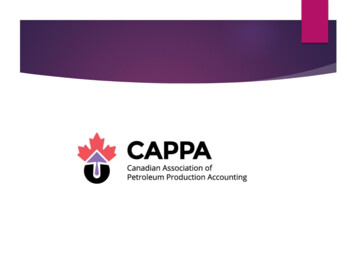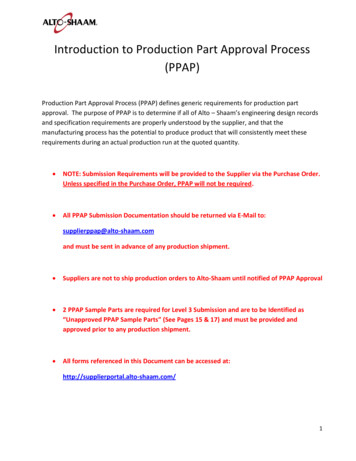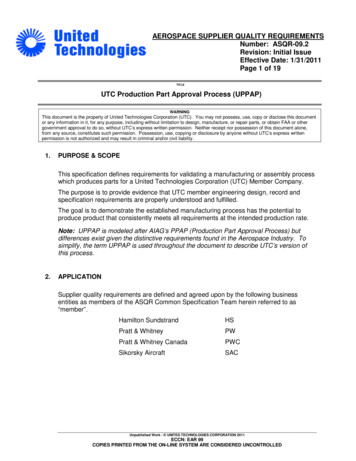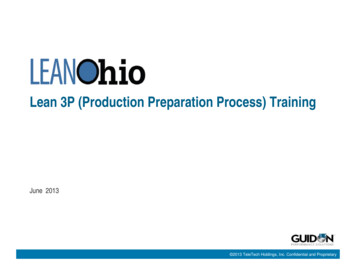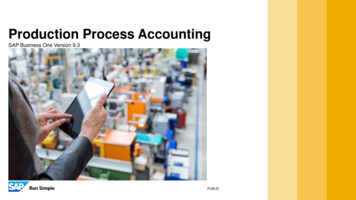
Transcription
Production Process AccountingSAP Business One Version 9.3PUBLICPUBLIC
ObjectivesAt the end of this topic, you will be able to: Describe the journal entries created in the production process.Explain the changes made in the inventory and variance accounts during production process. Explain the effect of resources on the produced items cost.Explain the summary information displayed in the Production Order and the variance report. 2018 SAP SE or an SAP affiliate company. All rights reserved. ǀ PUBLIC2
Business Scenario OC WoodTrend produces custom wooden doors. They use the Productionmodule in SAP Business One to record the production process. The production manager added resources for the employees and machinesused in the production process. OC WoodTrend uses the moving average method to manage their inventory. The accountant at OEC Computers, would like to learn about the journalentries made behind the scenes and to understand what happens to theinventory value in every step of production. 2018 SAP SE or an SAP affiliate company. All rights reserved. ǀ PUBLIC3
Production Process Postings – Basic ConceptNo Cost Variance1Issue for Production Journal EntryAccountDebit100Inventory account (Components)WIP Inventory account (Components)CreditReceipt from Production Journal EntryAccountInventory account (Produced Item)WIP Inventory account (Produced Item)100Resource Exp. account2Credit15015050WIP Resource account503Production Order Closing Journal EntryAccountDebitWIP Inventory account (Components)Credit100WIP Inventory variance account100WIP Inventory account (Produced Item)150WIP Inventory variance account150WIP Resource account50WIP Inventory variance account 2018 SAP SE or an SAP affiliate company. All rights reserved. ǀ PUBLICDebit504
WIP Accounts A WIP inventory account holds the inventory value of thecomponents in the time of production. Default accounts in the documents derive from the Item/Item Group/ Warehouse Master Data or defined in a rule inthe Advance GL Account Determination. In the document settings, we define which WIP account touse in the component transactions – components or parent. 2018 SAP SE or an SAP affiliate company. All rights reserved. ǀ PUBLIC5
Production Process Postings – Basic ConceptIncluding Cost Variance1Receipt from Production Journal EntryAccountDebitWIP Inventory Account (Produced Item)inventory account (Produced Item)Credit1503Production Order Closing Journal EntryAccountWIP Inventory Account (Produced Item)150Debit150WIP Inventory variance account150WIP Inventory Account (Components)120WIP Inventory variance account120WIP Resource Account2Issue for Production Journal EntryAccountDebit120Inventory Account (Components)WIP Inventory Account (Components) 2018 SAP SE or an SAP affiliate company. All rights reserved. ǀ PUBLIC50WIP Inventory variance account50Inventory account (Produced Item)20WIP Inventory variance account20120Resource Exp. AccountWIP Resource AccountCreditCredit50506
WIP and Inventory Offset P&L Accounts 2018 SAP SE or an SAP affiliate company. All rights reserved. ǀ PUBLIC P&L offset accounts can be used in productionpostings This account is the offset accounts to theInventory and WIP accounts Suitable for legal requirement in some EUcountries (CZ, SK, HU) Business practice in some organizations Key Benefit: Enhanced monitoring possibilities7
Production Cost InformationProduction OrderTypeStatusProduct No.Planned QtyWarehouseNo.Order DateStart DateDue DateStandardReleasedD00002201Components SummaryQuantitiesCostsActual Item Component CostActual Resource component costsActual Additional CostActual Product CostActual By-Product CostTotal VarianceJournal d QuantityCompleted QuantityRejected QuantityPlanned Times 2200DatesDue Date30Actual Closing DateOverdueProduction Order – D0000202.10.201802.10.2018 2018 SAP SE or an SAP affiliate company. All rights reserved. ǀ PUBLIC8
Variance reportFrom a Production Order Summary tab Total Variance field link arrowProduct Wooden DoorPlanned quantity 10Actual quantity 9Variance Report#TypeDescriptionQty Avg. Cost TotalVariance1Item componentWooden plate-1050-500-502Item componentHandle-2010-200-203Resource componentLathe Machine-2020-400-404ProductWooden Door911099005Product revaluationWooden Door00110110Only 9 wooden doors were received into inventory 2018 SAP SE or an SAP affiliate company. All rights reserved. ǀ PUBLIC9
Key PointsKey points from this topic: When working with perpetual inventory several journal entries are posted during theproduction process. A transaction is added when adding an Issue for Production, a Receipt from Productionand when closing the Production Order. If required, a P&L WIP accounts can also be involved in the production journal entries. There are several production scenarios that cause a variance in the final product cost.This variance is reflected in the production order’s closing journal entry. In the Summary tab of the Production Order, there is a summery of the product andcomponents costs. The Variance Report displays the breakdown of costs and quantities related to aspecific Production Order throughout its production process 2018 SAP SE or an SAP affiliate company. All rights reserved. ǀ PUBLIC10
2018 SAP SE or an SAP affiliate company. All rights reserved.No part of this publication may be reproduced or transmitted in any form or for any purpose without the express permission of SAP SE or an SAP affiliate company.The information contained herein may be changed without prior notice. Some software products marketed by SAP SE and its distributors contain proprietary software componentsof other software vendors. National product specifications may vary.These materials are provided by SAP SE or an SAP affiliate company for informational purposes only, without representation or warranty of any kind, and SAP or its affiliatedcompanies shall not be liable for errors or omissions with respect to the materials. The only warranties for SAP or SAP affiliate company products and services are those that areset forth in the express warranty statements accompanying such products and services, if any. Nothing herein should be construed as constituting an additional warranty.In particular, SAP SE or its affiliated companies have no obligation to pursue any course of business outlined in this document or any related presentation, or to develop or releaseany functionality mentioned therein. This document, or any related presentation, and SAP SE’s or its affiliated companies’ strategy and possible future developments, products, andplatforms, directions, and functionality are all subject to change and may be changed by SAP SE or its affiliated companies at any time for any reason without notice. The informationin this document is not a commitment, promise, or legal obligation to deliver any material, code, or functionality. All forward-looking statements are subject to various risks anduncertainties that could cause actual results to differ materially from expectations. Readers are cautioned not to place undue reliance on these forward-looking statements, and theyshould not be relied upon in making purchasing decisions.SAP and other SAP products and services mentioned herein as well as their respective logos are trademarks or registered trademarks of SAP SE (or an SAP affiliate company)in Germany and other countries. All other product and service names mentioned are the trademarks of their respective companies.See /index.epx for additional trademark information and notices.
When working with perpetual inventory several journal entries are posted during the production process. A transaction is added when adding an Issue for Production, a Receipt from Production and when closing the Production Order. If required, a P&L WIP accounts

